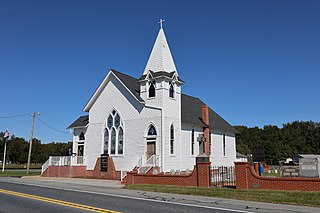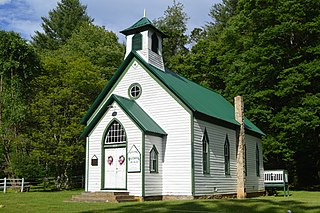
Choctaw County is a county located in the southwestern portion of the U.S. state of Alabama. As of the 2020 census, the population was 12,665. The county seat is Butler. The county was established on December 29, 1847, and named for the Choctaw tribe of Native Americans.

The Richmond Community Church is a historic church building on Fitzwilliam Road in Richmond, New Hampshire, United States. Built in 1838, it is a distinctive regionally early example of Greek Revival church architecture executed in brick. The church was listed on the National Register of Historic Places in 1983. It is now owned by a Methodist congregation.

The Methodist Episcopal Church South in Mount Sterling, Kentucky is a historic church at the junction of E. Main and N. Wilson Streets. It was built in 1883 and added to the National Register of Historic Places in 1991.
Mount Sterling is an unincorporated community in Choctaw County, Alabama, United States. Mount Sterling was once a prosperous antebellum community, with an economy based on cotton and timber, but today little is left other than a few scattered houses. One church building, the Mount Sterling Methodist Church, is listed on the National Register of Historic Places.

The John and Rosetta Lee House is a private residential structure located at 823 Calhoun Street in the city of Lapeer in Lapeer County, Michigan. It was added to the National Register of Historic Places on July 26, 1985.

St Andrew's Church is a heritage-listed Anglican church at 2 Mangerton Street, Toogoolawah, Somerset Region, Queensland, Australia. It was designed by Robin Dods and built from 1911 to 1912 by local builder Donald Alexander Menzies at a cost of £839. It was added to the Queensland Heritage Register on 21 October 1992.

Oakey Streak Methodist Episcopal Church is a historic church in Butler County, Alabama, United States. The congregation was organized in 1831, and the land where the current church sits was given to the church in 1851. A log building was erected soon after, replaced by the current frame structure around the 1880s. The church was expanded and a bell tower was added in 1903. Along with the adjacent Masonic Lodge, which was demolished in the 1940s, the church was the social center of the area.

Mount Pleasant Methodist Church is historic Methodist church in Waldron, Arkansas. It is a single-story wood-frame structure, originally built in 1891 on land donated by Joseph Self, a locally prominent farmer. The church is finished in weatherboard, and has a steeply pitched gable roof, with a bell tower at the front (north) end. A shed-roof addition extends to the south (rear) of the building. The interior features a distinctive gambrel ceiling, finished in flush pine boards painted white.

St. John's Methodist Church is a historic Methodist church located at Springfield Crossroads near Georgetown, Sussex County, Delaware. It was built in 1907, and is a one-story, frame church building sheathed in weatherboard in the Gothic Revival style. It sits on a raised brick foundation, has a steeply pitched gable roof, lancet windows, and features a two-story bell tower with steeple. The property also includes the church hall, which was originally constructed at the Civilian Conservation Corps Camp near Georgetown. It was moved to the property in 1949, and subsequently renovated. Adjacent to the church is the church cemetery, with burials dating to 1853.

Macedonia Methodist Church is a historic Methodist church located at Coffeytown, near Vesuvius, Amherst County, Virginia. It was built in 1896, and is a one-story, frame church building with vernacular Gothic Revival style influences. It sits on a random rubble stone foundation and has a gable roof with front bell tower. The interior features original unpainted American chestnut beaded board paneling on the walls and ceiling.

Son's Chapel is a historic church at 5480 East Mission in Fayetteville, Arkansas. It is a single-story rustic fieldstone structure, with front-gable roof and a squat square tower set off to one side. Built between 1933 and 1937, the building is an interesting and unusual mix of Gothic and Romanesque styles, with windows set under Romanesque arches, and the tower with a crenellated parapet. The church is the second for the congregation, which was established c. 1848 on land donated by Michael Son.

Surface Hill Uniting Church is a heritage-listed former Uniting church at Channon Street, Surface Hill, Gympie, Gympie Region, Queensland, Australia. It was designed by architect Hugo William Du Rietz and built from 1869 to 1937. It is also known as City Church, Surface Hill Methodist Church and Wesleyan/Wesley Church. It was added to the Queensland Heritage Register on 30 May 2003.

St Mary's Anglican Church is a State heritage-listed church at 11 Gordon Street, Mount Morgan, Rockhampton Region, Queensland, Australia. It was designed and built in 1888–1889 by Scottish-born Thomas Glen Cornes (1842–1903), superintendent of sawmills and carpenters at the Mount Morgan Gold Mining Company Limited. It was added to the Queensland Heritage Register on 25 August 2000.

The Ripton Community House, formerly the Ripton Congregational Church, is a historic former church and present community hall on Vermont Route 125 in the village of Ripton, Vermont. Built in 1864 for a Congregationalist church, it has since served as a community clubhouse and town-owned meeting hall, and is a fine local example of vernacular Greek Revival architecture. It was listed on the National Register of Historic Places in 1973.

The Griswold Civic Center Historic District is a small historic district containing eight civic and religious buildings, roughly bounded by Hubbard, Walnut, and Trowbridge Streets, in Allegan, Michigan. It was added to the National Register of Historic Places in 1987.

The American Legion Hall, Post 32 is a prominent social center in Greybull, Wyoming. Built in 1922 as a temporary church, it became an American Legion hall in 1935. Used as overflow space by nearby schools, it serves a diverse range of functions in the community.

The First United Methodist Church is a church located at 33112 Grand River Avenue in Farmington, Michigan. It was listed on the National Register of Historic Places in 2014.

The Richland Historic District is a commercial and residential historic district located in the center of Richland, Michigan, containing structures near the intersection of 32nd Street, D Avenue, and Gull Road. The district was listed on the National Register of Historic Places in 1997.

Mount Zion A.M.E. Church is a historic African American church in Tredyffrin Township, Chester County, Pennsylvania. Built in 1880 and expanded in 1906, Mount Zion was listed on the National Register of Historic Places on January 27, 2015. It was an important community gathering place for African Americans battling racial segregation of local schools in the 1930s.






















